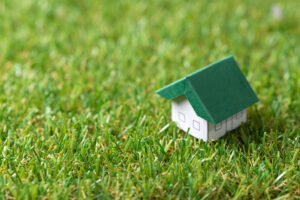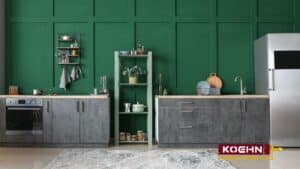Table of Contents
ToggleEco-friendly residential interior painting is an integral aspect of the transformation towards conscious living. In the evolving landscape of eco-friendliness, this practice has become increasingly significant. Our daily lives have seen eco-friendliness touch various facets, from the food we eat to the clothes we wear. Another transformative arena that is often overlooked is the space we call home.
The very walls that shelter us can also play a pivotal role in our endeavor to live harmoniously with the environment. This seemingly innocuous activity, when viewed through the lens of sustainability, provides profound insights into our environmental footprint.
Eco-friendly interior painting isn’t just a buzzword—it’s an invitation to create a healthier living space, reduce environmental impact, and embrace a lifestyle that acknowledges the symbiotic relationship between our homes and the world outside.
As we explore eco-friendly residential interior painting, we’ll uncover the environmental repercussions of traditional paints, the myriad benefits of their eco-friendly counterparts, and how we can make conscious choices that reverberate positively on both personal and planetary scales.
Whether you’re a homeowner looking to renovate, an environmental enthusiast, or simply someone curious about how painting can impact our ecological balance, this exploration promises to shed light on avenues where design meets sustainability.
Understanding Eco-Friendly Paints for Interior Painters
In a world where we are increasingly environmentally conscious, the choices we make in our homes reflect our commitment to a sustainable future. As interior painters and homeowners alike seek safer alternatives for residential interior painting, the spotlight is firmly on eco-friendly paints. But what makes paint truly “eco-friendly”?

Traditional Paints and VOCs
Traditional paints, while offering a plethora of colors and finishes, often contain harmful chemicals known as Volatile Organic Compounds (VOCs).
Volatile Organic Compounds (VOCs) are compounds characterized by high vapor pressure and low water solubility. Many of these compounds are human-made chemicals utilized in the production of various products, including paints, pharmaceuticals, and refrigerants.
VOCs can be found in industrial solvents, fuel oxygenates, and by-products produced by chlorination in water treatment. They are also components of petroleum fuels, hydraulic fluids, paint thinners, and dry cleaning agents. VOCs are known to contaminate groundwater.
When it comes to painting, the fresh chemical odor that emanates when a new layer of paint is applied is due to VOCs. These compounds are responsible for the recommendation to paint in well-ventilated areas. VOCs can pose health risks, both short-term and long-term.
Even after the paint dries and the scent dissipates, VOCs and other toxic biocides can linger in the air for months or even years. This poses potential dangers to all individuals, including adults, children, infants, and pets.
Advancements in the Paint Industry

Thankfully, the paint industry has seen significant advancements over the past decade. Many of today’s eco-friendly paints, including natural variants, offer excellent coverage, vibrant colors, and smooth application. But what truly sets them apart?
When it comes to commercially available interior paints, natural paints, often derived from substances like citrus, balsam, and minerals, are gaining popularity. These paints stand out because they are made from natural materials and are devoid of petroleum.
However, it’s essential to note that they often contain terpenes, which are VOCs (Volatile Organic Compounds) derived from plants. The silver lining? Unlike many conventional paints, natural paints do not release harmful biocides and fungicides into the air.
Milk paint, a unique blend of milk protein (known as “casein”) and lime, has historical significance. It was the preferred interior paint during colonial America. Not only is milk paint an excellent choice for interiors, but it also imparts a rich, deep color to wood, enhancing its natural grain. It’s a perfect choice for those looking to achieve a rustic, vintage look while staying eco-friendly.
Latex paint, especially those with minimal biocide and VOC levels, is emerging as a top-tier eco-friendly option. While it’s a more environmentally conscious choice compared to oil-based paints, users should exercise caution due to the presence of potent terpenes.
Latex, acrylic, and recycled latex paints all have their advantages provided they don’t contain harmful substances like mercury or lead. Latex paint tends to be less expensive and better for interior projects, whereas acrylic paint is more durable and better for exterior projects. Acrylic paint is mildew- and water-resistant, making it a great option for bathrooms. Latex paint is also easier to apply and is ideal for large surface areas.
It is crucial that you steer clear of oil- and solvent-based paints, which are detrimental to both health and the environment.
To guarantee their eco-friendliness, many paints now come with certification seals. The GREENGUARD label, for example, ensures the paint contains less than 50 grams of VOCs per liter. Similarly, the Green Seal indicates strict adherence to environmental standards.
Regardless of the paint type you choose, safety should always be paramount. Ensure the room is well-ventilated during the painting process and for several days afterward to allow any fumes to dissipate. An essential safety tip to remember is the potential danger of lead-based paints.
These paints are highly toxic, posing significant risks, especially to pets and children who might ingest dry paint chips. If there’s any suspicion of lead-based paint in your home, it’s imperative to seek a certified professional’s expertise. Affordable test swabs are also available online for those who wish to test their walls for lead paint.
With a plethora of options available, homeowners can now make informed, sustainable choices without compromising on quality or aesthetics. As we continue to prioritize our planet’s health, a move towards eco-friendly paints is a testament to a commitment to sustainability and health.
Contact us here if you would like to find the best painting contractor for your residential or commercial needs.
How To Choose Eco-Friendly Residential Painting Services for Your Home.
Not all Painting contractors offer eco-friendly residential painting services, but they are increasingly stepping up to offer eco-friendly solutions that align with homeowners’ environmental values. If you’re a homeowner looking to hire a painting contractor with a green ethos, here’s how to ensure you’re making the right choice:

- Start with green research: Dive into the sustainable residential interior painting industry to understand what sets eco-friendly contractors apart. A painting contractor like Koehn painting can provide you with insights and help you prioritize green practices in your home painting projects.
- Choose contractors who use low and zero VOC paints: VOCs in traditional paints can be harmful to the environment and health. Opt for contractors who can demonstrate their commitment to using paints labeled as low-VOC or no-VOC.
- Seek out contractors using natural paint brushes: Brushes made from renewable resources, such as bamboo handles and vegan bristles, have a smaller environmental footprint. Ask if your contractor uses or is open to using such tools.
- Opt for contractors who recommend energy-efficient paints: Some paints can deflect heat, leading to energy savings. Contractors who are aware of and recommend such paints, especially light-colored or sun-reflective ones, are likely more attuned to eco-friendly practices.
- Ensure responsible paint disposal practices: After the job, leftover paint should be disposed of sustainably. Ensure your contractor has a plan for eco-friendly disposal, whether it’s through community programs or other green initiatives.
- Check for licensing and green credentials: While a contractor’s license and insurance are essential, also inquire about any eco-certifications or sustainable practices they’re committed to.
- Quality shouldn’t be overlooked: A green approach shouldn’t come at the expense of quality. Ensure your chosen contractor uses top-notch, sustainable materials and offers a durable finish.
- Engage in green dialogues: When discussing your project, emphasize your preference for sustainable practices. A contractor’s willingness to discuss and adapt to these preferences can be a good indicator of their commitment to eco-friendly practices.
Choosing interior painters with a focus on sustainability ensures that your home’s fresh coat of paint is not only beautiful but also kind to the environment. By considering the above points, you can partner with a professional home painting service that shares your vision for a greener future.
The Future of Eco-Friendly Residential Interior Painting
As we wrap up our exploration of eco-friendly residential interior painting, it’s clear that this isn’t just a fleeting trend but a significant pivot in how we approach home design and renovation. The choices we make today reverberate into the future, laying the foundation for what’s to come.
With the global paint and coatings industry valued at about $160.03 billion in 2021 and having a projected compound annual growth rate of 5 percent, and homeowners more aware of environmentally friendly options, the future of eco-friendly residential interior painting looks promising. As awareness grows and technologies advance, we can anticipate a surge in demand for paints that are not only aesthetically appealing but also ecologically responsible.
Major paint brands are already investing in research and development to produce even more sustainable options, suggesting that the paints of tomorrow will be even less taxing on the environment and potentially even beneficial.
Home interiors will be seen not just as personal retreats but as micro-ecosystems that play a role in the broader environmental context. This heightened consciousness will drive innovation and better practices across the board—from production and packaging to application and disposal.
Every brushstroke is quickly becoming a statement of intent and a commitment to a world where our homes are extensions of our environmental ethos. As we look ahead, it’s not just about colors and finishes but about creating spaces that resonate with the principles of sustainability, health, and harmony.
So, as you stand on the precipice of your next painting project, remember that your choices are powerful. They can paint a brighter, more sustainable future, one room at a time. Koehn stands with you by offering you the best paints for your home that are also eco-friendly. But of course, if you have your own preference, we can also work with that too.
If you want to learn more about Koehn and our painting services, feel free to get a quote from us.





